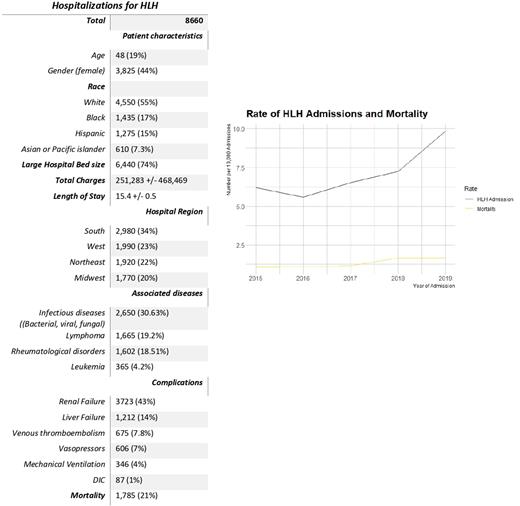Abstract
Background Hemophagocytic lymphohistiocytosis (HLH) is a rare and life-threatening condition triggered by an excessive inflammatory response leading to multiorgan failure with high mortality rates. Early diagnosis and treatment are imperative for survival. However, the diversity in etiologies and clinical presentations make it very challenging to diagnose. HLH has been widely described in the pediatric population. While it is being increasingly recognized in adults, the current knowledge of epidemiological characteristics is limited. The aim of our study is to evaluate the incidence and factors associated with HLH among hospitalized patients in the US using a large nationwide database.
Methods We performed a retrospective analysis with the National Inpatient Sample (NIS) using ICD10-CM and PCS codes to identify adult patients hospitalized with a primary or secondary diagnosis of HLH between October 2015 and December 2019. We described patient characteristics including location, charges, length of stay (LOS), associated diagnosis, and inpatient complication variables. We used R studio survey package to analyze survey data included in the NIS to account for the sampling weight and obtain accurate estimates of the included population. Lastly, we included a graph to describe the annual trend of HLH admissions and mortality.
Results Data from 8,660 admissions with HLH were included, of which 1785 (21%) patients died during the hospitalization. Patients with HLH tended to be males (56%), with a mean age of 48 years, fifty five percent of the population were white, 17% black, 15% Hispanic, and 7.3% Asian. Associated diagnosis included DLBCL (9.1%), other Non-Hodgkin lymphoma (4.3%), Hodgkin lymphoma (3.8%), Leukemia (4.2%), NK-Cell lymphoma (2%), Viral infections (11.56%), fungal infections (17.85%), bacterial infections (1.16%), and rheumatological disorders (18.51%). Most patients were hospitalized in larger hospitals (74%). A higher percentage of patients were admitted in the South (34%), followed by West (23%), Northeast (22%), and Midwest (20%), with a mean hospitalization cost of $ 251,283. An increasing trend was noted in admissions for HLH. However, the mortality rate has remained stable, despite the recent approval of the interferon-gamma monoclonal antibody emapalumab-lzsg in November of 2018.
Conclusions HLH in adults is an increasingly identified disorder that remains a challenging and critical condition. This nationwide data analysis demonstrates its geographical distribution and the persistently high mortality associated with it. Further studies are needed to improve early diagnosis, help understand its pathophysiology to identify patients at risk, and allow for improved treatment.
Disclosures
No relevant conflicts of interest to declare.
Author notes
Asterisk with author names denotes non-ASH members.


This feature is available to Subscribers Only
Sign In or Create an Account Close Modal